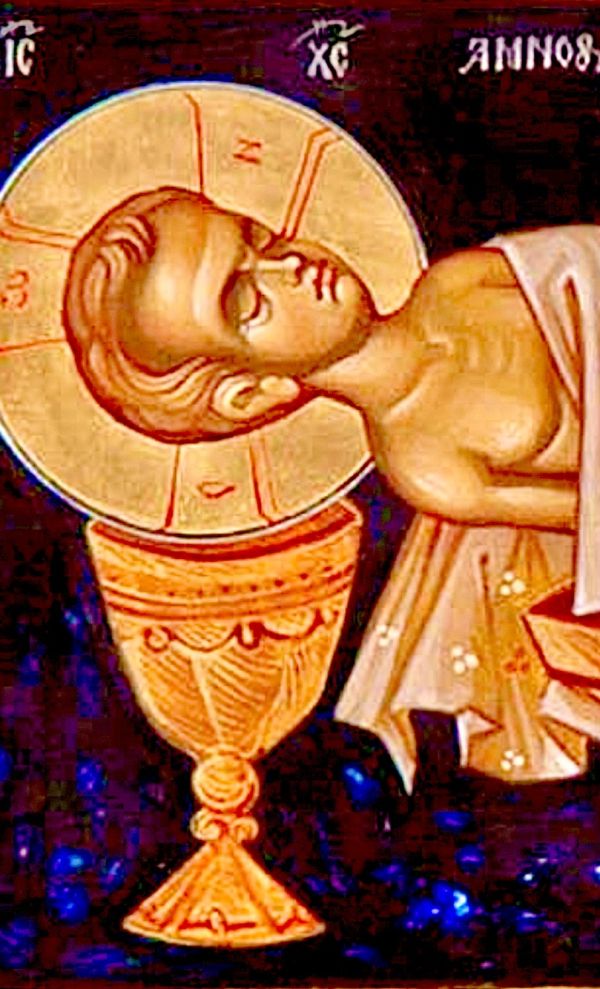No triumphal march: fragments, to reconcile
(Jn 6:52-59)
The Eucharistic theme conveys a fundamental message, about the quality of Life of the Eternal that we can already experience here and now.
The Life of the Eternal is not the effect of external “belief” in Jesus. Conviction that would stop us, and lose 'contact'.
Instead, it becomes reciprocal, evolves, recovers us, as in a natural energy.
Here is the raw Food, and Drink: by 'chewing’ Him and 'crushing’; 'drinking’ Him and 'gulping’, ‘quaffing’ Him and ‘swilling down' even [verbs used in the Greek text].
Total assimilation, which is converted into an experience - Gift from Person to person.
The Food to be fed on is not a seal, but an everlasting, convoking motion. Not a logical, compassed and consenting doctrine, but Word-event that fully engages.
For this reason, here is the Person of Christ - in his true and full human reality, offered and broken; in his authentic teaching and vicissitude as the paschal lamb, amidst wolves that shredded him.
It is the raw means by which the Life of the Eternal is given and preserved.
In this sense the Eucharist received in bare Faith is the real (not symbolic) Presence of the Risen One.
The harshness of the vocabulary used - not very intimate - scratches the lives of believers with concrete effects in the first person.
«To have Life» is to be united with Jesus - but not in a sweet, sentimental, or dazzling way.
The Pact of a new kingdom is existence in God: a charge that’s not exhausted, and ushers us into the paradoxical, wounded glory of the community of sons.
The Eucharist is the reference point of Church recognizing itself, defines what it is called to be. And must not find its perennial bonds elsewhere.
With polemical crudeness, Jesus insists on proposing Himself as the Easter Lamb who rudely chopped up and totally absorbed, frees from slavery - introducing his own intimates in angular but true trajectories.
His proposal passes through an impertinent transgression of legalism: it was absolutely forbidden to assume blood, considered the seat of life.
To make the story of the total Christ one's own - so far removed from controlled thinking - is to mark a contestation of norms and habits or fashions.
In short, others "manna" or external affective dependencies, diluted, conditioning-centred, are not even pale figures of the Living Food.
The life Communion with the concrete Person of Lord is only that of the Son with the Father: cultivating it, we dream of it and keep it there, along with our events - so that they are nourished by same Spirit.
By letting the motivations and the world of images linked to the Lord's Supper evolve, we allow ourselves to be led by the efficacious Sign. It will guide and even lead, precisely where we need to go.
By surrendering to such a memorial that gives intimate impetus, something will happen - for the soul to take the field. We will see other stages give birth.
Here is the Judgement of the wounded Crucified, who sprinkles authentic life (even if inclement); without admirable attunements all around.
This by taking our flesh and blood [involves the body and moods] which assimilates to Him the discarded, those outcasts of earthly thrones and opportunistic entanglements.
This is shocking for the vulgar outside mentality that raises defences and seeks approval, recognition, achievement; mirages of success, things that everyone wants.
Decrease that doesn’t attract enthusiastic consensus, but rather flies in the face of normal expectations of the usual choruses of glory - of the acclamation’ symphonies for whirlwind success and available, but mitigating.
Flesh and Blood: thrown into the furrows of history. We also being involved without dampening the Spirit; in a personal and intimate way: One Body, assimilated into Him and His affair.
First fruits of no triumphal march: we too became food, crumbs and fragments, to reconcile.
Otherwise, the time of the Promises cannot be fulfilled.
[Friday 3rd wk. in Easter, May 9, 2025]












